 Aircraft Oxygen Control System Testing
Aircraft Oxygen Control System Testing
The Partial Pressure of Oxygen also defined as pressure exerted by oxygen component of air decreases in direct proportion to air pressure, while the altitude increases it become more difficult for humans to inhale oxygen which unfortunately if prolonged cause hypoxia and eventually death. To avoid hypoxia oxygen monitoring & controlling system in military aircraft maintains minimum Partial Pressure of Oxygen equivalent of sea level. Hence it is very important that reliability of such lifesaving system is uncompromised but how? Well, it’s CME! Time and again our state of art Altitude Chambers have stood on its reputation of the most preferred in defence industry for such sophisticate reliability testing.
The Partial Pressure of Oxygen also defined as pressure exerted by oxygen component of air decreases in direct proportion to air pressure, while the altitude increases it become more difficult for humans to inhale oxygen which unfortunately if prolonged cause hypoxia and eventually death. To avoid hypoxia oxygen monitoring & controlling system in military aircraft maintains minimum Partial Pressure of Oxygen equivalent of sea level. Hence it is very important that reliability of such lifesaving system is uncompromised but how? Well, it’s CME! Time and again our state of art Altitude Chambers have stood on its reputation of the most preferred in defence industry for such sophisticate reliability testing.
Be it Gaseous Oxygen Systems or Liquid Oxygen Systems or even On-Board Oxygen Generation Systems, our chamber is customisable to test such systems. The chamber mentioned here has ability to simulate altitude range from ambient to 10mbar (100,000ft) with varying temperature range between -70 °C to +180 °C and ramp rate of 5°C/min average from -55°C to +85° C with (50 Kg alloy +30 Kg steel) and ≤500W thermal load. It has cascade refrigeration system with brazed plate heat exchanger and semi-hermetically sealed reciprocating compressor which is built on our On-Demand Cooling technology which ensures significant power saving.
| Description | Specification | ||||
| Workspace Dimensions – WxDxH | |||||
| mm | 1000 | x | 1000 | x | 1000 |
| In | 39 | x | 39 | x | 39 |
| Volume | |||||
| Ltr | 1000 | ||||
| Cuft | 35 | ||||
| Temperature Range | |||||
| °C | -70 | To | 180 | ||
| °F | -94 | To | 356 | ||
| Ramp Rates | |||||
| Cooling °C/min | 5 [-55 to +85] | ||||
| Heating °C/min | 5 [-55 to +85] | ||||
| Altitude Range | |||||
| mbar | Atmospheric to 1 | ||||






























